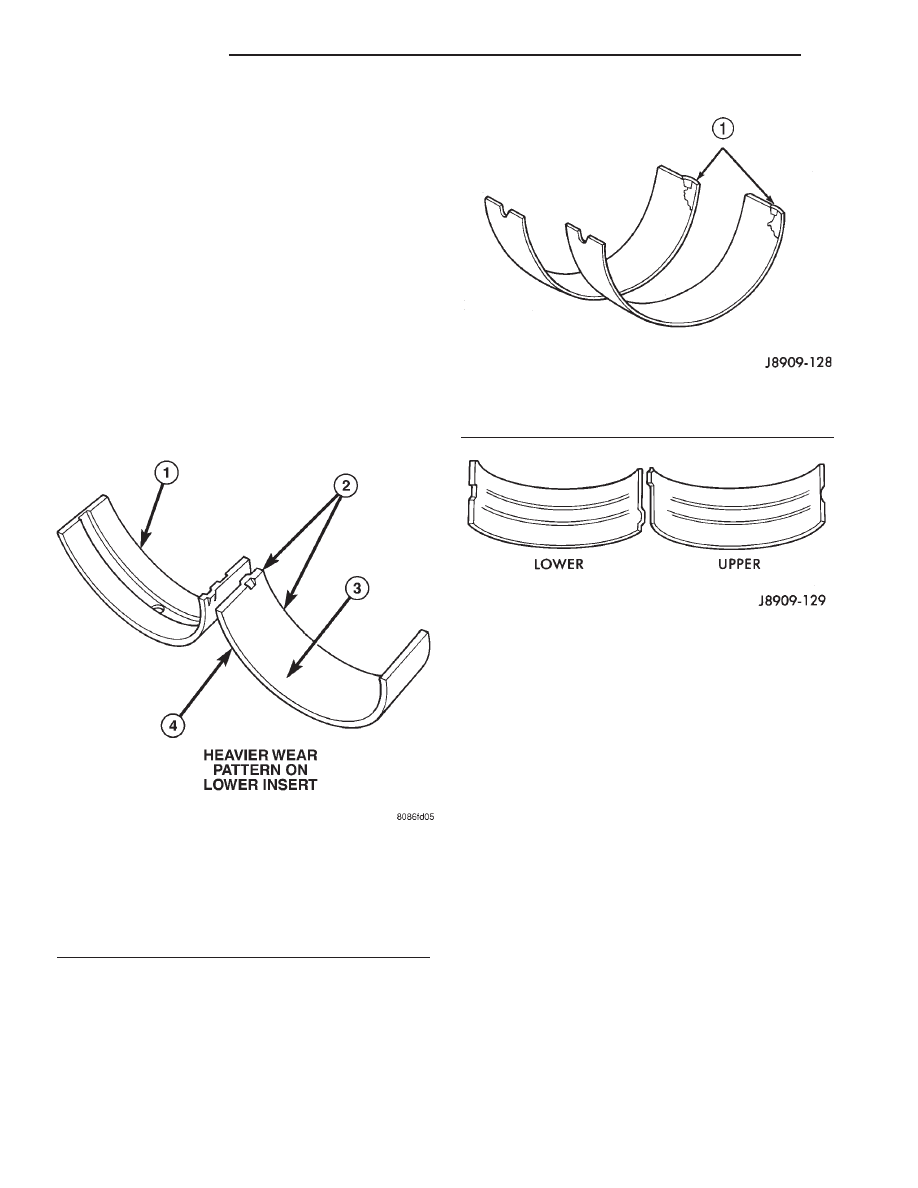Dodge Dakota (R1). Manual - part 461

(20) Install the radiator or radiator and condenser,
if equipped with A/C.
(21) Fill the cooling system (Refer to 7 - COOLING
- STANDARD PROCEDURE).
(22) Connect negative cable to battery.
CONNECTING ROD BEARINGS
STANDARD PROCEDURE CONNECTING ROD
BEARING - FITTING
Inspect the connecting rod bearings for scoring and
bent alignment tabs (Fig. 30) (Fig. 31). Check the
bearings for normal wear patterns, scoring, grooving,
fatigue and pitting (Fig. 32) . Replace any bearing
that shows abnormal wear.
Inspect the connecting rod journals for signs of
scoring, nicks and burrs.
Misaligned or bent connecting rods can cause
abnormal wear on pistons, piston rings, cylinder
walls, connecting rod bearings and crankshaft con-
necting rod journals. If wear patterns or damage to
any of these components indicate the probability of a
misaligned connecting rod, inspect it for correct rod
alignment. Replace misaligned, bent or twisted con-
necting rods.
(1) Wipe the oil from the connecting rod journal.
(2) Use short rubber hose sections over rod bolts
during installation.
(3) Lubricate the upper bearing insert and install
in connecting rod.
(4) Use piston ring compressor to install the rod
and piston assemblies. The oil squirt holes in the
rods must face the camshaft. The arrow on the piston
crown should point to the front of the engine (Fig.
33). Verify that the oil squirt holes in the rods face
the camshaft and that the arrows on the pistons face
the front of the engine.
(5) Install the lower bearing insert in the bearing
cap. The lower insert must be dry. Place strip of Plas-
tigage across full width of the lower insert at the cen-
ter of bearing cap. Plastigage must not crumble in
use. If brittle, obtain fresh stock.
(6) Install bearing cap and connecting rod on the
journal and tighten nuts to 45 N·m (33 ft. lbs.)
torque. DO NOT rotate crankshaft. Plastigage will
smear, resulting in inaccurate indication.
(7) Remove the bearing cap and determine amount
of bearing-to-journal clearance by measuring the
width of compressed Plastigage (Fig. 34). (Refer to 9 -
ENGINE - SPECIFICATIONS) for the proper clear-
ance. Plastigage should indicate the same clear-
Fig. 30 Connecting Rod Bearing Inspection
1 - UPPER BEARING HALF
2 - MATING EDGES
3 - GROOVES CAUSED BY ROD BOLTS SCRATCHING
JOURNAL DURING INSTALLATION
4 - WEAR PATTERN — ALWAYS GREATER ON UPPER
BEARING
5 - LOWER BEARING HALF
Fig. 31 Locking Tab Inspection
1 - ABNORMAL CONTACT AREA CAUSED BY LOCKING TABS
NOT FULLY SEATED OR BEING BENT
Fig. 32 Scoring Caused by Insufficient Lubrication
9 - 32
ENGINE 2.5L
AN
CAMSHAFT & BEARINGS (IN BLOCK) (Continued)